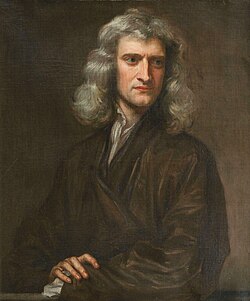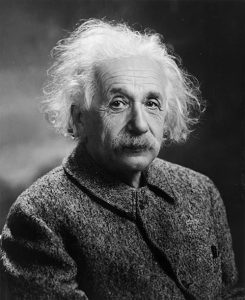 First published in 1687, in Latin, the ideas contained within ‘Philosophiæ Naturalis Principia Mathematica’ are better known as Newton’s Laws of Motion. These laws work extremely well in most cases. Over time, certain minor discrepancies began to be noticed. For example, the orbit of Mercury does not quite accord with the theory. Einstein came up with the concept of Relativity in the early part of the 20th century. The earlier discrepancies could be explained. All was well with the scientific world once more. But, over time, certain new, but still minor discrepancies began to be noticed. It seems that a new theory, or at least a modification of the old ones, is required. Newton held sway for two centuries. Newton (pictured above) plus Einstein (pictured below) were good for another one hundred years.
First published in 1687, in Latin, the ideas contained within ‘Philosophiæ Naturalis Principia Mathematica’ are better known as Newton’s Laws of Motion. These laws work extremely well in most cases. Over time, certain minor discrepancies began to be noticed. For example, the orbit of Mercury does not quite accord with the theory. Einstein came up with the concept of Relativity in the early part of the 20th century. The earlier discrepancies could be explained. All was well with the scientific world once more. But, over time, certain new, but still minor discrepancies began to be noticed. It seems that a new theory, or at least a modification of the old ones, is required. Newton held sway for two centuries. Newton (pictured above) plus Einstein (pictured below) were good for another one hundred years.
 But this a family history blog. What is the relevance of a physics lesson? In ‘The quick and the dead (and the living)’ I constructed a theory that Patrick began training as a hairdresser having met Ernest Quick when both were experiencing difficulties within the disability pension system. And that this meeting probably took place in either 1922 or 1923. How long did this theory last before ‘minor discrepancies’ began to emerge? Years? Months? Less than a day! And the discrepancy was not minor. The metaphorical ink was barely dry before I discovered another document.
But this a family history blog. What is the relevance of a physics lesson? In ‘The quick and the dead (and the living)’ I constructed a theory that Patrick began training as a hairdresser having met Ernest Quick when both were experiencing difficulties within the disability pension system. And that this meeting probably took place in either 1922 or 1923. How long did this theory last before ‘minor discrepancies’ began to emerge? Years? Months? Less than a day! And the discrepancy was not minor. The metaphorical ink was barely dry before I discovered another document.
At his wedding in April 1920 (at St Augustine’s Church, Sanford Avenue, Brighton), Patrick’s occupation was shown as ‘labourer’. The Parish record of the baptism of William Thomas Stanley in November of the same year, (also at St Augustine’s Church) has his occupation as ‘hairdresser’. (I had not previously accessed the baptismal record, relying only on the birth record for my information.) The decision to become a hairdresser must have been taken much earlier than previously thought.
Seven months (maximum) is not enough time to qualify. I have found a reference to a six-month course that still required an employer to provide the bulk of the training. This echoes the traditional craft apprenticeship. The conscription of apprentices was the subject of debate in Parliament. Some thought that apprentices should be exempt until they had finished their training. But as young, generally fit, mainly single men, they were exactly what the Army wanted most. At the end of the war, some apprentices went back to pick up where they had left off. Some had seen a different world and did not want to go back. Others were not capable of resuming their earlier career path. And too many had died. This combination of circumstances created new opportunities for others.
The National Federation of Hairdressers imposed regulations on its members ‘prohibiting the teaching of the trade to any persons other than an apprentice indentured for a minimum of four years.’ Whether Patrick was subject to this restriction is not known. It would have been more accurate to describe his occupation in late 1920 as ‘Trainee Hairdresser’, but such pedantry is probably out of place on a baptismal record.
